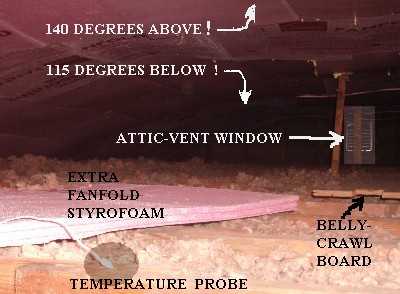I wanted to get my house cooler in the summer, so I installed two roof-turbines.
I monitored temperatures in the attic... 140 degrees... and house temperatures stayed at about 93 degrees (without AC)... The roof turbines had almost ZERO effect! so I placed a BOXFAN under one roof turbine... still only made a couple degrees difference! So i cut some big holes in my SOFFIT to let cooler air in... but it still didnt make much difference in ACTUAL MEASURED temperature up in the
attic. Most people place a turbine up there or two and feel good about it... but actual temperature measurements might make you rethink it! Finally, i bought some cheap 1/4 inch thick styrofoam in the fold-out sheets. it costed about 200 bucks to
cover the whole attic CEILING as pictured here. I had to do the belly-crawl up there
for a couple days... but NOW my attic is down to about 115 degrees! and the house seems to stay no higher than 83 degrees with air conditioning OFF! After many months of measurements and experiments, i believe the summer house temperature is a result of ATTIC OVERHEATING plus AVERAGE outside temperatures (day vs night). I was surprised to realize the OUTSIDE temperature at night gets pretty low, even in summer... about 70 degrees commonly here in St. Louis. But the daytime temperature can get up in the 90's. making the average about 80. But if you ATTIC is 140 degrees then your home will not be 80..... it will be about 90! so, I wanted to post this to help others who may want to reduce their homes overheating in summer. This method worked for me... but once you get attic temperatures down to about 115 degrees, then further attic cooling is not much effect due to the AVERAGE day/night temperatures tend to keep the house at about 80 to 83 degrees. We have found that
83 degrees is about the upper limit of comfort without running the air conditioner.
We have not used airconditioning much at all this summer since i did this to the attic !!!
The effect of the insulation makes the heat rise up and out through the roof turbine, and pulls cooler air in through the soffit vents i cut open. Here's a picture of the finished attic with insulation attached to ceiling. I used cheap poker chips as large washers so the screws wont pull through the thin styrofoam. Any gaps in the edges of the styrofoam must be tight for best effectiveness.
